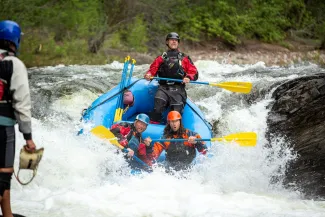The Roaring Fork River begins on Independence Pass, flowing through Aspen, connecting with creeks as it continues through the Roaring Fork Valley. Residents and visitors alike enjoy water sports along the river including rafting, paddle boarding, and fly fishing. As the snow melts in spring, the river rises, creating thrilling conditions for rafting and kayaking, but fast currents can be dangerous for those who are unprepared or unaware.
How To Aspen Guides
River Safety & Tips
River Safety Tips:
- Wear a Personal Flotation Device (PFD) while enjoying water sports of any kind.
- Be aware of swift moving water, particularly during spring runoff which typically occurs April – June.
- Strainers and boulders move from season to season and day to day, scout conditions when recreating in our rivers.
- Unknown obstacles can be present below a calm surface.
- Water temperatures are close to freezing.
- Rocks and other obstacles near the river may be slippery and caution should be exercised at all times.
For questions about water levels, or better yet, for a fun guided experience with local experts contact our local outfitters.
River Safety and Etiquette
from Colorado Parks & Wildlife
River Safety
- The river is powerful and always changing. Be familiar with current conditions, including water level and weather.
- Know the section of the river you are boating.
- Your skills and experience must equal the river and its conditions.
- Don’t be bashful – if you want to scout a rapid, scout a rapid if possible.
- Know and be aware of river “features” – both natural and man-made: holes, wrap rocks, undercuts, rock sieves, horizon lines across the river, low head dams as well as significant rapids and “strainers” (trees in the river).
- Watch your surroundings. This includes the weather.
- Be aware of your limitations and those of your fellow boaters and of your equipment.
- Always consider the consequences – an accidental swim is always a possibility.
- Boating alone is not recommended. Two or more boats are safer.
- Be prepared for self-rescue and the rescue of others should an accident occur. It is up to you and everyone in your boat to be able to help each other.
Safety Gear
- Always use good, quality equipment. Carry a first aid and patch kit, an extra PFD, a spare oar or paddle, a pump, a bailing device, and bow stern line. Have rescue gear: rescue ropes/throw lines, a knife, carabiners, and a whistle.
- Dress for a possible cold water swim and changing weather. Wear pile or fleece (no cotton). Protect your feet with sturdy footwear that won’t come off in the river. Carry extra synthetic clothing, food, and water.
- Bring a wetsuit or drysuit – and wear it when conditions merit. Hypothermia is a risk any time of the year while boating on the river.

